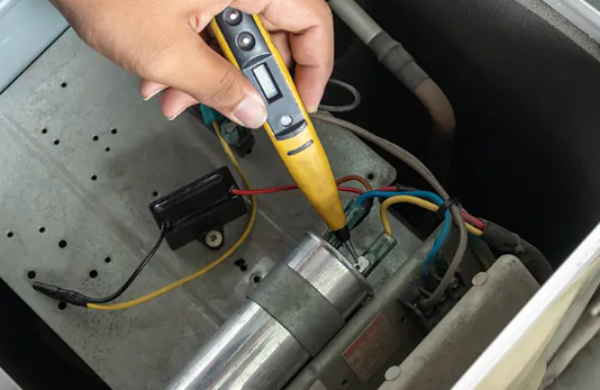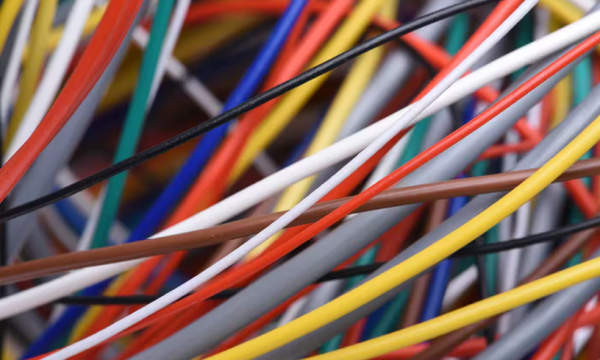An AC capacitor, also known as an alternating current capacitor, is a type of capacitor specifically designed to work with AC (alternating current) electrical systems.

Capacitors store and release electrical energy in the form of an electric field. In AC circuits, capacitors affect the flow of electrical current by alternating the direction of the energy flow as the current changes direction. These capacitors are designed to handle the alternating voltage and current found in AC systems.
Here are a few key points about AC capacitors:
-
Application in AC Circuits: AC capacitors are commonly used in various applications in alternating current circuits. They are particularly useful for power factor correction, coupling and decoupling AC signals, timing circuits, filtering noise, and energy storage applications.
-
Types of AC Capacitors: There are different types of capacitors that can be used in AC circuits, such as:
- Film Capacitors: These capacitors are known for their stability and reliability in AC applications.
- Electrolytic Capacitors: While primarily used in DC systems, electrolytic capacitors with proper voltage ratings can also be used in certain AC applications.
- Motor Run Capacitors: These capacitors are specifically designed for use in AC motors to improve starting efficiency and power factor correction.
- Power Factor Correction Capacitors: These capacitors help improve the power factor in AC systems by adjusting the phase relationship between voltage and current.
-
Voltage Rating: AC capacitors are rated for specific voltage levels to ensure safe operation in AC circuits. It is crucial to select capacitors with voltage ratings that are appropriate for the AC system to prevent damage or failure.
-
Phase and Frequency Considerations: Since AC currents alternate in direction and change polarity, it is important to consider phase shifts and frequency characteristics when working with AC capacitors. Capacitors can introduce phase shifts and affect the behavior of AC circuits.
AC capacitors are integral components in AC circuits, providing various functions such as power factor correction, filtering, energy storage, and signal processing. They play a crucial role in ensuring the efficiency, stability, and performance of AC electrical systems.

Tips for Connecting AC Capacitors
Connecting AC capacitors properly is essential to ensure the safe and effective operation of electrical circuits. Here are some tips for connecting AC capacitors:
-
Polarity:
- Electrolytic capacitors are polarized components and must be connected with the correct polarity to prevent damage. Make sure to connect the positive terminal of the capacitor to the positive side of the circuit and the negative terminal to the negative side.
-
Voltage Ratings:
- Select capacitors with voltage ratings that are suitable for the AC circuit. The voltage rating of the capacitor should be higher than the peak voltage in the AC circuit to prevent breakdown and damage.
-
Safety Precautions:
- When working with AC circuits, always ensure that the circuit is properly de-energized and follow safety protocols to prevent electric shocks or injuries.
-
Mounting and Placement:
- Securely mount the capacitors on the circuit board or in the system to prevent mechanical stress or vibration that could lead to component failure. Maintain proper spacing between components for heat dissipation.
-
Filtering Capacitors:
- When connecting filtering capacitors in AC circuits, ensure they are connected in the correct orientation to effectively filter out high-frequency noise or interference.
-
Grounding:
- Connect the ground terminal of the capacitor to the designated ground point in the circuit to ensure proper grounding and electrical safety.
-
Parallel and Series Connections:
- Understand the implications of connecting capacitors in parallel or series in AC circuits. When connecting capacitors in parallel, the total capacitance increases. In series connections, the voltage rating adds up while the capacitance decreases.
-
Decoupling Capacitors:
- Properly connect decoupling capacitors near integrated circuits to stabilize power supply voltages and filter out noise. Place these capacitors close to the power pins of the IC for maximum effectiveness.
-
AC Motor Capacitors:
- When connecting capacitors in AC motor circuits, ensure that start and run capacitors are connected correctly as per the motor manufacturer's recommendations to optimize motor performance and efficiency.
-
Testing and Verification:
- Once the capacitors are connected, test the circuit to verify proper functionality. Use a multimeter or oscilloscope to check voltage levels, capacitance values, and overall circuit performance.
By following these tips and guidelines, you can ensure correct and safe connections of AC capacitors in electrical circuits, leading to reliable operation and optimal performance of your electronic systems.
How to Wire AC Capacitor [5 Steps]
Wiring an AC capacitor correctly is crucial to ensure optimal performance and safety in electrical circuits. Here are five steps to guide you through the process of wiring an AC capacitor:
-
Safety Precautions:
- Before working on any electrical circuit, ensure that the power source is turned off and the circuit is de-energized to prevent the risk of electric shock. Always follow appropriate safety procedures and wear personal protective equipment if necessary.
-
Identify Capacitor Terminals:
- AC capacitors typically have two terminals: a positive terminal marked with a “+” or a longer lead, and a negative terminal marked with a “-” or a shorter lead. Identify these terminals on the capacitor before proceeding.
-
Connect to AC Circuit:
- Connect the positive terminal of the AC capacitor to the corresponding positive side of the AC circuit. This typically involves connecting it to the live or “hot” wire in the circuit.
-
Connect Ground Wire:
- If the capacitor requires grounding, connect the ground wire from the circuit to the ground terminal of the capacitor. Proper grounding is important for safety and to prevent electrical interference.
-
Secure Connections:
- Once the capacitor is wired to the circuit, ensure that all connections are securely tightened. Use appropriate tools to tighten terminal screws or connectors to prevent loose connections that could lead to overheating or electrical hazards.
These steps provide a general guideline for wiring an AC capacitor in an electrical circuit. It's important to consult the specific wiring diagram or manufacturer's instructions for the capacitor and the circuit you are working on to ensure proper installation and operation. If you are unsure about any steps or if you are dealing with high-voltage circuits, it is recommended to seek the assistance of a qualified electrician or technician to ensure safe and accurate wiring practices.
Where Do The Wires Go on an AC Capacitor
In the context of air conditioning (AC) systems, capacitors play an essential role in starting and running the compressor and fan motors. AC capacitors typically have three terminals: HERM (compressor), FAN (fan), and C (common). Knowing where to connect the wires on an AC capacitor is crucial for proper operation of the system. Here is how the wires are typically connected on an AC capacitor:
-
HERM Terminal: This terminal is designated for connecting the compressor motor wire. The wire from the compressor motor is typically connected to the HERM terminal on the capacitor.
-
FAN Terminal: The FAN terminal is used for connecting the wire from the condenser fan motor. The condenser fan motor wire is connected to the FAN terminal on the capacitor.
-
C (Common) Terminal: The C terminal serves as the common connection point. It is where the other ends of the compressor and fan motor wires are connected, along with the common wire coming from the power source.
To summarize:
- The compressor motor wire is connected to the HERM terminal.
- The condenser fan motor wire is connected to the FAN terminal.
- The common wire from the power source and the other ends of the compressor and fan motor wires are connected to the C (Common) terminal.
It's important to note that incorrect wiring of the capacitor can lead to motor failure, inefficient operation, or damage to the system. If you are uncertain about where the wires should go on an AC capacitor or if you are not experienced with electrical work, it is recommended to seek the assistance of a qualified HVAC technician to ensure the proper wiring and safe operation of your AC system.
What Color Wires Go on AC Capacitor
In the context of air conditioning systems, the color-coding of wires can vary based on the specific installation and the country or region where the system is installed. However, there are some common color-coding conventions that are often used in air conditioning systems in the United States. Here is a general guide to the color-coding of wires typically found in AC systems:
-
Common Wire (C):
- The common wire, which is typically neutral or return wire, is often designated with the color white.
-
HERM Terminal (Compressor):
- The wire connecting to the HERM terminal (compressor) on the capacitor is often yellow.
-
FAN Terminal (Condenser Fan):
- The wire connecting to the FAN terminal (condenser fan) on the capacitor is often brown.
-
Start Wire (Herm Terminal):
- The wire connecting to the start terminal in certain types of capacitors can be black.
-
Other Possible Wire Colors:
- In some cases, you may also encounter wires in different colors such as red for power, blue for common, purple for "fan on," and so on. It is essential to refer to the wiring diagram or manufacturer's instructions for your specific AC unit to determine the correct wire connections.
Because wire color-coding standards can vary across manufacturers and regions, it is crucial to always refer to the wiring diagram provided with your air conditioning unit or consult a professional HVAC technician to ensure the correct wire connections to the AC capacitor. Making accurate connections is essential for the safe and efficient operation of your air conditioning system.
What Happens If Wire an AC Capacitor Wrong
Incorrectly wiring an AC capacitor can lead to various issues that can adversely affect the operation of the air conditioning system. Here are some potential consequences of wiring an AC capacitor incorrectly:
-
Component Damage:
- One of the most immediate consequences of wiring an AC capacitor incorrectly is potential damage to the capacitor itself. Reversed polarity or improper connections can cause the capacitor to fail, leading to a breakdown in the operation of the compressor or fan motor.
-
Motor Failure:
- Incorrectly wiring the capacitor can result in the compressor or fan motor not starting or running as intended. This can lead to motor overheating, increased power consumption, or even complete motor failure over time.
-
Reduced Efficiency:
- An improperly wired capacitor can result in reduced efficiency of the air conditioning system. It may lead to the motors working harder than necessary, which can cause increased energy consumption and reduced overall cooling performance.
-
System Malfunction:
- Incorrect wiring can cause the air conditioning system to malfunction, such as the compressor not turning on, the fan not working properly, or the system not cooling efficiently. This can result in discomfort in your living or working environment.
-
Circuit Damage:
- In some cases, incorrect wiring may cause damage to other components within the AC system or the electrical circuit. This can result in more extensive repairs and increased costs to rectify the issues.
-
Fire Hazard:
- In extreme cases where the wiring is severely incorrect or if there are significant electrical faults, there is a risk of fire hazard. Incorrectly wired components can overheat, leading to potential electrical fires.
To avoid these potential issues, it is essential to follow proper wiring practices, refer to the wiring diagram provided with the air conditioning unit, and consult a professional HVAC technician if you are uncertain about the correct wiring of the AC capacitor. Proper installation and wiring are critical for the safe and efficient operation of your air conditioning system.



